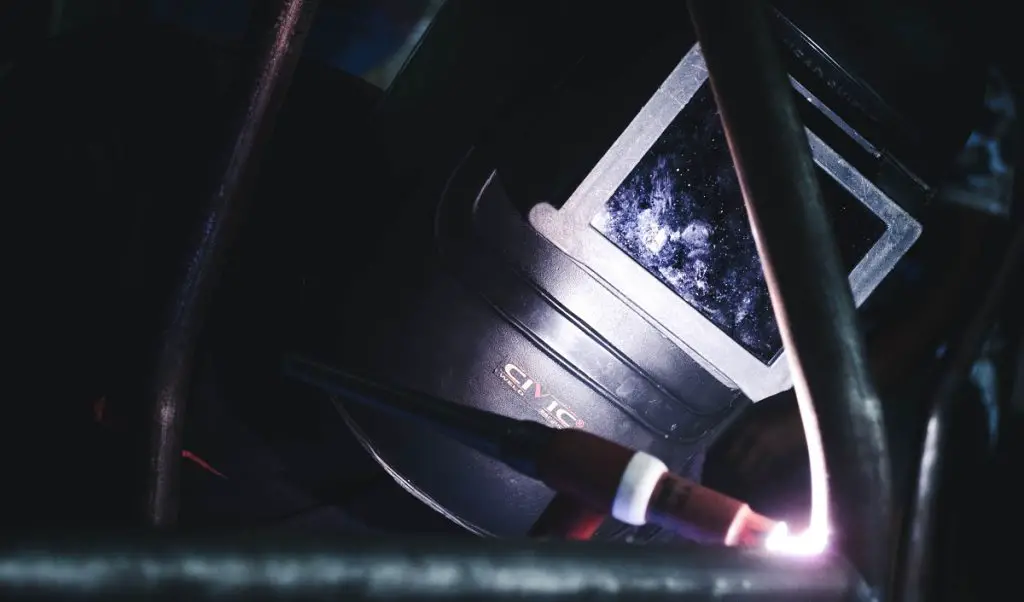Welding lens shades vary based on the process and amperage used. Typical shade numbers range from 4 to 14. Select the appropriate shade to protect your eyes from harmful radiation during welding.
The tables below show the recommended welding helmet lens shade number based on the type of welding and your amperage range. Protecting your eyes is crucial: you should never start welding with insufficient lenses.
Each process generates different levels of radiation, requiring specific shade recommendations.

Table of Contents
Stick Welding
Stick welding uses a consumable electrode, and the arc generates moderate to high light radiation levels, depending on the amperage used.
| Amperage Range | Recommended Shade Number |
|---|---|
| < 60 | 8 |
| 60-160 | 10 |
| 160-250 | 12 |
| 250 + | 14 |
MIG Welding
MIG processes produces moderate levels of light radiation, requiring lens shades in the mid-range.
| Amperage Range | Recommended Shade Number |
|---|---|
| < 60 | 7 |
| 60-160 | 10 |
| 160-250 | 12 |
| 250+ | 14 |
TIG Welding
TIG welding produces more light radiation than the other processes, and you will have to choose a darker lens than the other alternatives.
| Amperage Range | Recommended Shade Number |
|---|---|
| < 50 | 8 |
| 50-120 | 10 |
| 120-175 | 12 |
| 175+ | 13 |
Flux Core Welding
FCAW generates moderate to high levels of light radiation, with higher amperage producing brighter arcs.
| Amperage Range | Recommended Shade Number |
|---|---|
| < 60 | 8 |
| 60-160 | 10 |
| 160-250 | 12 |
| 250+ | 14 |
Plasma Cutting
This process uses a constricted, high-velocity ionized gas jet to cut through metal. PAC generates moderate to high light levels, depending on the amperage used.
| Amperage Range | Recommended Shade Number |
|---|---|
| < 20 | 8 |
| 20-40 | 9 |
| 40-60 | 10 |
| 60-80 | 11 |
| 80-300 | 13 |
Welding Lens Shade Specifications
Welding lens shade specifications are crucial in selecting the appropriate eye protection during welding processes. Lens shades, ranging from 4 to 14, offer varying visible light transmission levels, infrared, and ultraviolet protection. These specifications ensure your eyes are shielded from harmful radiation, tailored to the welding process and amperage used.
| Shade Number | Visible Light Transmission | Infrared Protection | Ultraviolet Protection | Suitable Welding Processes |
|---|---|---|---|---|
| 4 | 45% | Low | Low | Light Oxyfuel Gas Welding |
| 5 | 20% | Low | Moderate | Moderate Oxyfuel Gas Welding |
| 6 | 12% | Moderate | Moderate | Heavy Oxyfuel Gas Welding |
| 7 | 8% | Moderate | High | Low Amperage MIG & FCAW |
| 8 | 5% | High | High | Low Amperage Stick & TIG |
| 9 | 3% | High | High | – |
| 10 | 2% | High | High | Medium Amperage Stick, MIG, TIG, FCAW |
| 11 | 1.5% | High | High | – |
| 12 | 1% | High | High | High Amperage Stick, MIG, TIG, FCAW, PAC |
| 13 | 0.8% | High | High | – |
| 14 | 0.5% | High | High | Very High Amperage Stick, MIG, TIG, FCAW, PAC |
Welding lenses are made of specialized materials that absorb or reflect specific wavelengths of light. The shade number corresponds to the level of protection provided, with higher numbers offering greater filtration and darker lenses.
Higher amperage generally produces brighter arcs and requires darker lens shades.
ANSI Z49.1:2012 offers detailed advice on which welding lens to use under numerous circumstances.
How to Select the Correct Lens Shade
Select the correct welding process and amperage range based on your project and material thickness. This gives you a good starting point using the tables above.
You should select a lens that is too dark to see the weld zone, and incrementally go to a lighter shade until you can see the weld zone without going below the minimum. This is the safest option to avoid going too light from the start.
You will have personal preferences for lens shades due to differences in vision, sensitivity, and comfort. Test various shades within the recommended range to find the most suitable option.
Auto-darkening helmets automatically adjust the lens shade based on the detected arc brightness.
